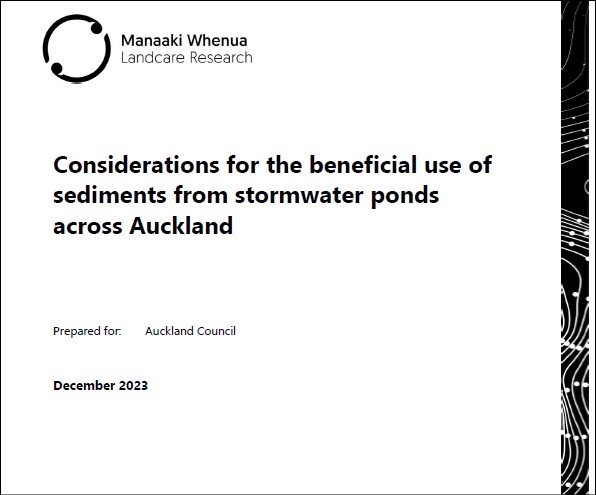Considerations for the beneficial use of sediments from stormwater ponds across Auckland
Author:
Jo Cavanagh, Robyn Simcock, Hadee Thompson-Morrison, Manaaki Whenua – Landcare ResearchSource:
Manaaki Whenua – Landcare Research | Auckland Council Healthy WatersPublication date:
2023Topics:
EnvironmentExtracts from the Summary:
Project and client
- Healthy Waters, Auckland Council, is responsible for maintaining over 650 stormwater ponds in the Auckland region. This includes periodic removal of sediments (‘desilting’), which reduces pond capacity.
- Auckland Council contracted Manaaki Whenua – Landcare Research to provide advice on what factors to consider to enable the beneficial reuse of stormwater pond sediments.
Objectives
- Identify and assess the factors influencing the beneficial reuse of stormwater pond sediments.
- Develop a decision flow chart for determining management options for pond sediments.
Methods
- We carried out discussions with council staff and contractors, participated in a workshop hosted by Healthy Waters (March 2023), and reviewed the relevant literature to identify the available information on stormwater pond sediment and practices influencing its beneficial reuse.
- We sampled seven ponds across Auckland to provide an indication of the variation in metal contaminant concentrations, and selected attributes for assessing beneficial use (pH, nutrient levels).
- We undertook a beneficial reuse trial at Portland Road to assess the suitability of excavated sediments (dredged and digger-excavated) for native plant growth compared with site-won topsoil.
- Information from the above research was used to develop a decision flow chart to help inform the beneficial use of sediments by Auckland Council. ...
Results
- An analysis of sediments from a cross-section of pond types in the Auckland region showed that the excavated sediments generally contained soil properties beneficial for plant growth, and in most cases contained greater nutrients than in situ or imported topsoils. ...
Conclusions...
- Considerations for the beneficial use of sediments removed from stormwater ponds and the beneficial use of ‘surplus’ soils have substantial overlaps. These overlaps include the nature of beneficial use, contaminant concentrations identified as acceptable for reuse, and appropriate characterisation of the sediments or soils to match an identified beneficial use.
- The beneficial use of stormwater pond sediments is more complicated than for surplus soils due to the additional requirement for dewatering (and potentially also ‘ripening’/aeration) of the sediments to enable beneficial use. Nonetheless, in both cases a key challenge is linking the source site with an appropriate recipient site. The use of intermediary sites to stockpile and, where appropriate, process (e.g. dewater, ripen, amend sediments) is seen as a potential solution. ...
...
Recommendations
- Further information is required to ensure environmental risks are appropriately managed. Specifically, evaluation is required to assess:
− the potential leaching of metals during sediment ‘ripening’ processes (including dewatered, flocculated geobag sediments) to ensure that any associated risk to ground- or surface water is appropriately managed
− the potential for ponds to contain acid-sulphate soils
− whether the flocculants used are compatible with the proposed beneficial use (in the first instance this would simply involve a stock-take and literature review of flocculants commonly used in desilting operations). - The pH of removed sediments should be routinely measured. This is a critical measure to assess the suitability of the sediment for use, particularly to identify when lime addition may be required to facilitate beneficial plant growth and reduce the potential for leaching of metals.
- Geotechnical suitability and compaction rates post-placement may need to be assessed to inform some beneficial uses; for example, the use of sediments in a landscaping bund, and for both geobag-contained and uncontained (ie digger-excavated, or removed or slit geobag) sediments.
- Sediments should be sampled in situ, prior to desilting operations, to provide a greater lead-time to assess potential beneficial use options. This information should be systematically captured to build a greater understanding of the beneficial (texture, total carbon, nitrogen, phosphorus, Olsen phosphorus) and constraining (pH, trace elements) characteristics of sediments in stormwater ponds across Auckland.
- The Canadian Inspection and Maintenance Guide for Stormwater Management Ponds and Constructed Wetlands (TRCA 2018) provides wider information on practices for the management and maintenance of stormwater treatment facilities that may be useful for Healthy Waters to consider, alongside an evaluation of existing design, maintenance, and desilting operations. Similarly, Australian guidance on the dredging of acid-sulphate soil sediments and associated dredge spoil management (Simpson et al. 2018) may be useful to consider if the potential occurrence of acid-sulphate soils in stormwater ponds is identified.
- It would be helpful to systematically capture costs and volumes of sediment removed from different ponds to build a better picture of what items create the greatest cost, and to consider that alongside costs and benefits of beneficial use.
- Efforts to facilitate the beneficial reuse of stormwater pond sediments should be coordinated with emerging efforts to facilitate the beneficial reuse of surplus soils. ...
Manaaki Whenua – Landcare Research for Auckland Council
December 2023
